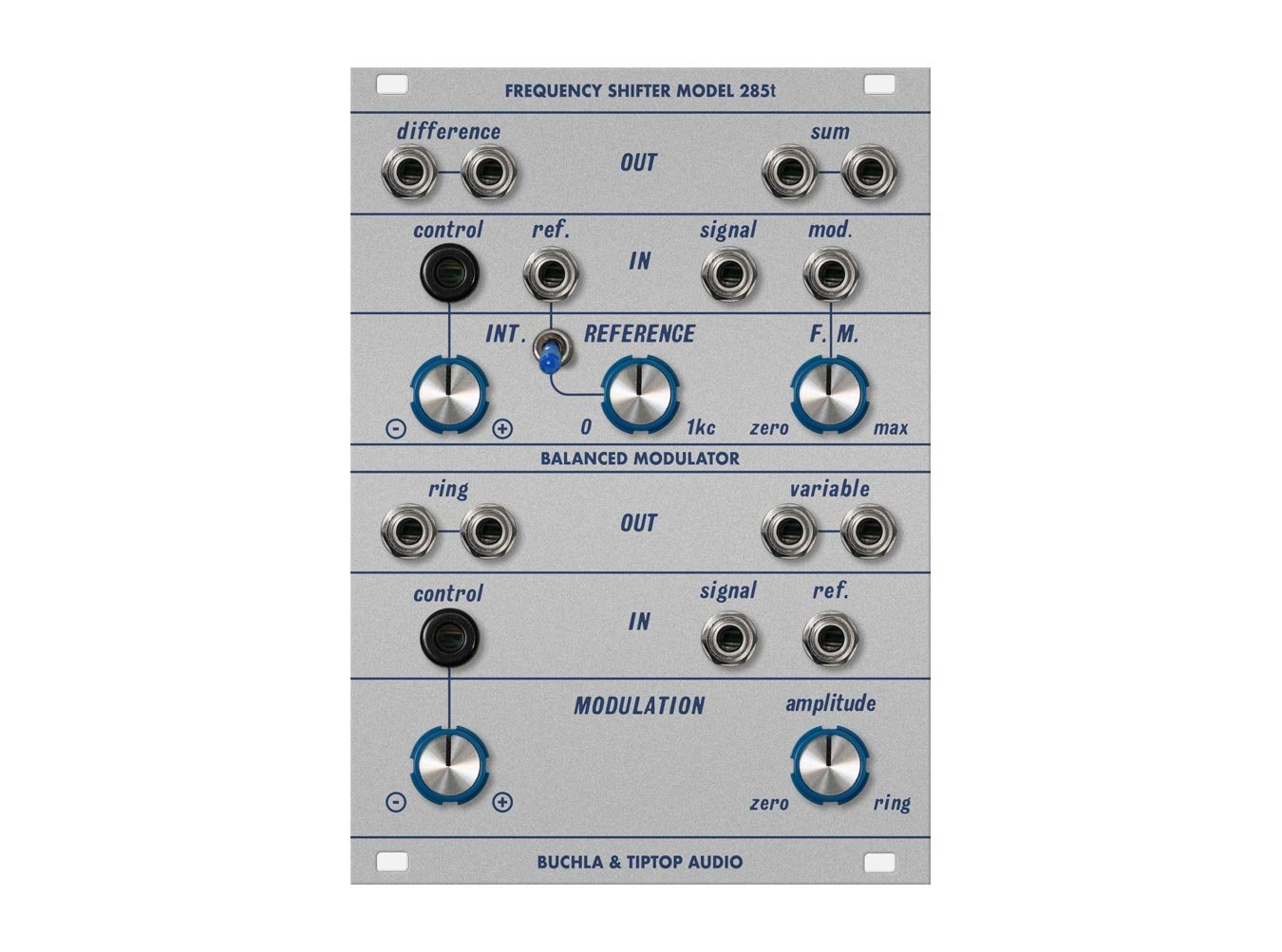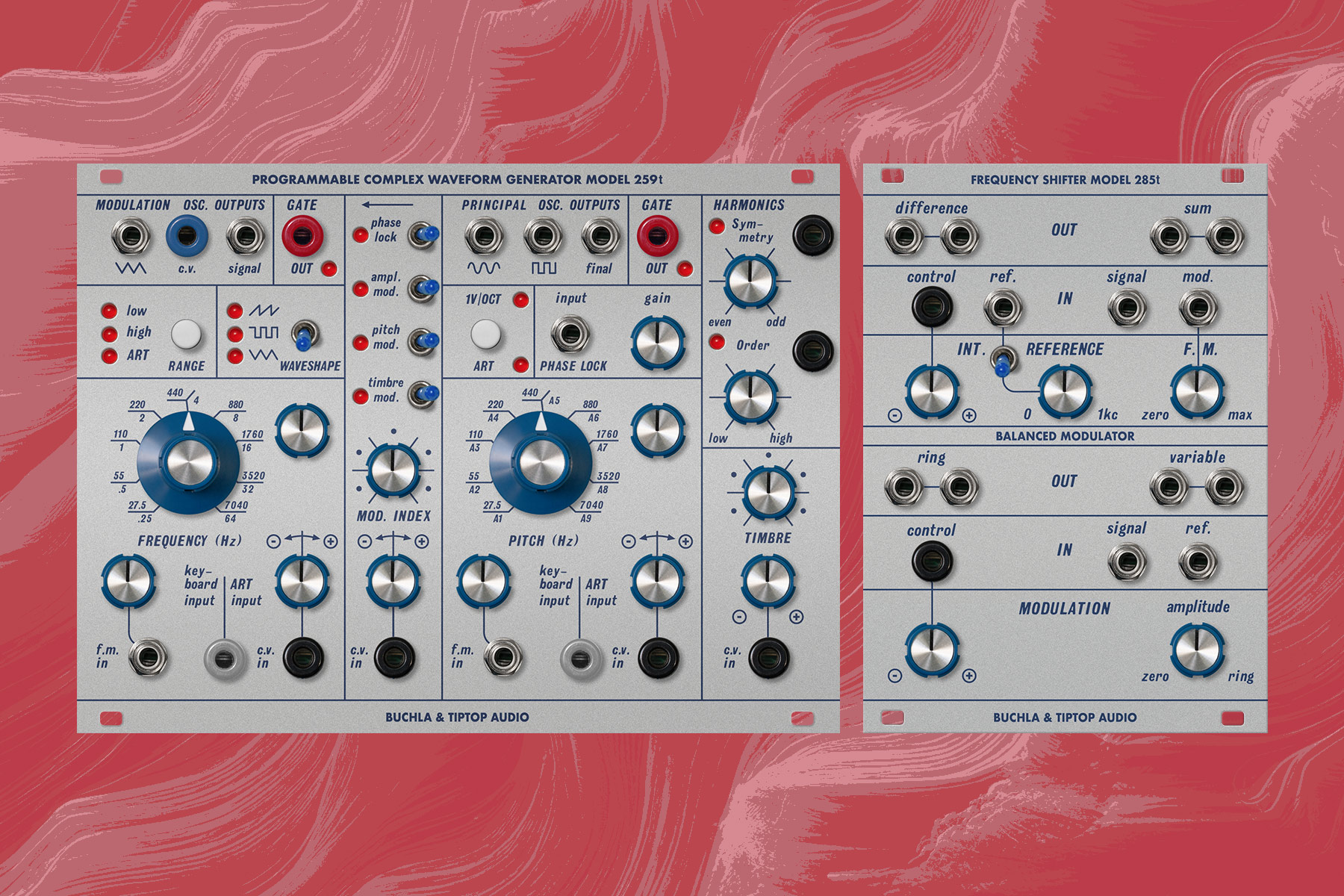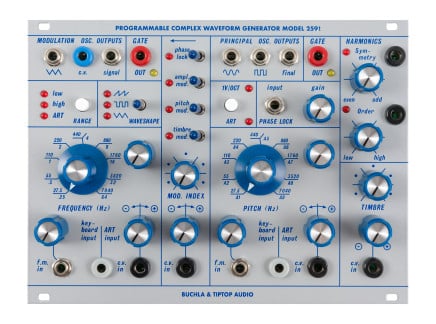Now something of a Superbooth tradition, Tiptop Audio is presenting their latest Buchla modules revamped for the Eurorack modular format. Now with a number of classic 200 Series modules under their belt, Tiptop is finally coming out with their long-awaited 259t—a Eurorack version of the original complex oscillator. There's also the 285t, a flexible frequency shifter and ring modulator sure to spice up any patch.
Let's dive into these two modules and see how they expand the Tiptop-Buchla ecosystem.
Getting Freq-y: 285t Frequency Shifter

Now that most of the "hits" of the Buchla 200 Series have been covered, Tiptop Audio is starting to pull out some of the deep cuts—the 285t is one such module. Specializing in an array of delightfully clangorous timbres, the 285t allows you to frequency shift, ring modulate, and blend between the two to incredible degrees of control. The magic of the 285t is perhaps in the fact that all of these options are available simultaneously, giving you abundant flexibility in constructing patches.
We've talked about frequency shifters in our Weird FX article series, but we'll offer a quick recap if you're unfamiliar. Despite the similar definitions of the words "pitch" and "frequency," frequency shifters have more in common with ring modulators than pitch shifters. Pitch shifters are more "musical" and harmonic in that they maintain the relative relationships of overtones after processing, but frequency shifters like the 285t simply add a flat amount of shift to all components of the input signal. The more harmonics present, the more disruption in their interval relationships as frequency shifting is applied.
The Frequency Shifter section at the top offers both Sum and Difference outputs—that is, upward and downward frequency shifting. Using the internal oscillator, you can apply up to 1kHz of shifting, but an external Reference input is also available if you'd like to use it. Bipolar CV and linear FM inputs for the Reference oscillator allow you to get even gnarlier if you like.
Ring modulation is created by combining the upward and downward frequency shifter components together. Of course, you can blend Sum and Difference externally to create ring mod timbres, but the Balanced Modulator at the bottom also makes this possible for you, and with a variable blend control to boot. With an applied control voltage, the resulting dynamically morphing timbres can bring depth and richness to any sound source.

[Above: a full Tiptop Audio Buchla system at Superbooth 2024]
The Return of a Cult Classic: 259t Complex Waveform Generator

Here's the one that we're sure a lot of folks have been waiting for ever since Tiptop Audio unveiled their original set of Buchla modules. Indeed, the 259t is a Eurorack recreation of the original 200 Series Programmable Complex Waveform Generator. It is the original complex oscillator, and, somewhat ironically given its rarity, remains the definitive template for Eurorack designers, software developers, or anyone else looking to recreate or emulate its particular sonic characteristics. In fact, the growing number of complex oscillators derived from or inspired by the 259 means there's a good chance that a lot of folks with Eurorack systems haven't even heard an original 259 (let alone used one).
As such, the availability of an authentic 259 in Eurorack is kind of a big deal. Of course, the 259t has a few functional changes compared to the original—this is to be expected for some of the more niche features of the original. But for most, the sound will be the most important thing, and Tiptop has repeatedly proven they're more than capable of accurately capturing the magic of these original Buchla designs.
If you're not familiar with the concept of a complex oscillator, thankfully the 259t is directly descended from the archetype that all similar designs have followed since its inception. Two wide-ranging oscillators are mounted together behind a single panel: a Principal Oscillator which is usually the one you'll listen to in most patches, and a Modulation Oscillator to affect the other—but of course, it can be used on its own, too! Between the two oscillators, you can find a variety of different standard waveforms via switches and discrete outputs.
What makes this module "complex" is the variety of rich timbres that it can create, with two primary means of doing so. Running down the middle of the module are a few switches that allow internal routing of the Modulation Oscillator to affect the Principal—namely its amplitude (AM), pitch (FM), and timbre. The Timbre section corresponds to the Final output of the Principal oscillator, with its controls found on the right side of the module. The Timbre knob itself is a (now classic) Buchla wavefolder, with additional controls above for the Symmetry (balance) and Order (brightness) of even and odd harmonics.
Given the vast array of possible timbres, we should also mention the Phase Lock feature, which offers both a switch in the middle of the module and an external input for the Primary Oscillator. Not to be confused with hard sync or even Phase-Locked Loops (PLLs), it's less about affecting the timbre and more about locking into to cleaner harmonicity. In other words, locking into integer frequency ratios between the oscillators and eliminating the dissonance and beating that occurs from being slightly out of tune. Unlike the other switches, which route the Modulation Oscillator to the Primary, this switch does the reverse—as hinted by the arrow above. You can also pass external sources (ideally a clean, strong pulse waveform) into the Primary input for extended chaining of oscillators.
Hang On.. What is ART?
Obviously, the 259t is able to be used just like any other analog oscillator in your modular rig. The original 259 also featured remote control and auto-tuning capabilities, interfacing with computer-controlled systems introduced with the Buchla 300 series. While those systems worked surprisingly well for the time they were introduced in the 1970s, Tiptop Audio offers a different approach in the 259t—something which happens to be a key component of their current endeavors outside of the Buchla line.
The full story of ART is a bit beyond the scope of this article, but you can check out our overview article covering this new protocol. But here's the gist as it pertains to the 259t: when paired with an ART controller module, such as the OCTOPUS MIDI-ART converter or Quad Quantizer CV-ART interface, the 259t is able to be quickly and easily tuned to precision without any worry of fiddling with fine tuning or drift across multiple octaves.
ART is somewhat similar to MIDI—it's a digital data stream with absolute pitch references rather than relative voltages. But unlike MIDI, ART connections are made with standard 3.5mm Eurorack patch cables, and the speed of data transmission is much higher than MIDI. So if you do need to modify ART connections on the fly, the updates are instantaneous.
One of the biggest appeals of ART is the facility to construct discrete polyphonic modular systems with ease—both in the actual tuning process but also in module selection. This is why the 259t's oscillators have gate outputs at the top—active notes often need a corresponding gate to control envelopes and VCAs, so it makes most sense to include this at the destination of the ART message. So if you've been dreaming about polyphonic complex oscillators as Eurorack modules, the inclusion of ART on the 259t actually makes it attainable.
Buchla Bananza
The release of the 259t is sure to get a lot of synth patchers excited, but don't sleep on the 285t! Either module is sure to bring some rich timbres to your modular system, and both would be a true sonic powerhouse. Alongside the inclusion of ART on the 259t, we'll also note that Tiptop Audio is beginning to ship the remaining modules from the first wave of polyphonic ART designs. With even more new and old-new things on the horizon, we'd suggest keeping an eye out for whatever Tiptop has in store next.













